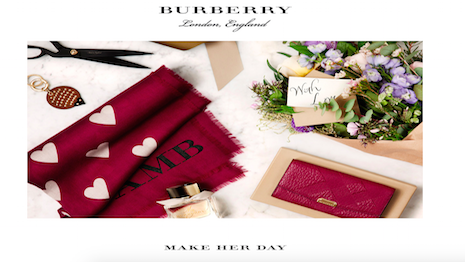Women may drive the luxury industry, but men are more frequent purchasers in numerous sectors, according to new research from The Shullman Research Center.
While identifying the consumer is the first step for brands, everything from income to concerns and worries is to some degree correlated with gender. Better understanding the differing behaviors of men and women and the nuances of their thought processes and goals can help marketers tailor a message for maximum effectiveness.
"When discussing this issue with luxury marketing people, many agree that men are more likely the ones that make the purchases but their belief is the women are the influencers who get their men to make the purchase for the household or as gifts for the woman," said Bob Shullman, founder/CEO of The Shullman Research Center.
Boys and girls
As has been extensively documented, men tend to have more buying power. Three times as many male respondents as women respondents reported personal income more than $100,000, and an additional 23 percent of men reported incomes of $50,000 to $99,999 compared to just 14 percent of women.

Luxury shoppers
This difference in income comes despite equal levels of education, and is likely related to women being more likely to have children under 18 in the household men being more likely to have full-time employment. These numbers show that even as the U.S. modernizes and strives for equality at home and at work, the numbers still align with some stereotypes.
From the viewpoint of a marketer, content that relies on an appeal to parenthood will likely be more effective on women.
However, in accordance with income disparities, the end consumer is not necessarily the most frequent purchaser. Men are more than twice as likely as women to have purchased fine watches or jewelry in the past year.
While this data may be surprising given that the jewelry market overwhelmingly targets women, many men purchase it as a gift. Brands therefore need to ensure that messages are attuned to the likely purchaser as much as the end consumer – a difference most pronounced on holidays such as Valentine’s Day, Mother’s Day and Father’s Day.

Burberry Mother's Day email
Men are also more likely to have purchased luxury items over the past 12 months, 33 percent to women's 22 percent. However, this, along with the similar data by jewelry and other sectors, does not account for the frequency and total value of these purchases.
While men may be more likely to have purchased luxury goods, including jewelry, many of these men may have a small number of transactions for special occasions. The likely purchaser for goods with more aspirational or entry-level pricing may be men purchasing them as gifts or for self-use, but the market share of this group could be comparatively small.
Interestingly, the concerns of men and women are similar. Women are a few percentage points more likely to worry about the issues included in the survey – ranging in topic from health to finances to social justice. The major exception is inflation, a concern to 28 percent of men but only 18 percent of women.
Financial goals are also similar, but women again tend to be more likely to identify with a particular goal, sometimes by at least 10 percentages. This goal-oriented attitude offers run contra to gendered assumptions but suggests that aspiration-oriented content could be an effective marketing message to accompany products aimed at women.
A change is gonna come
While gender differences continue to influence marketing messages, brands are also taking note of progressive new norms that seek to dispel gendered notions.
In particular, luxury fashion labels are breaking with tradition, bending the rules of gendered dressing through their designs and marketing.
From co-ed fashion shows and unisex collections to cross dressing in campaigns, brands are incorporating themselves into the larger conversation around gender identity. While androgyny has infiltrated the fashion industry as a whole, is this unisex approach an effective strategy for heritage luxury labels (see story)?
Additionally, as pressure for gender equality mounts in developed countries, more women are beginning to make a name for themselves among the ultra-wealthy.
Although the ultra-high-net-worth demographic is primarily men, women are an increasingly important subset of the group, according to a recent report by WealthInsight.
The compound annual growth rate for the female UHNW population from 2010 to 2014 was 5.3 percent, compared to 4.4 percent for men. For the hospitality industry as well as other businesses capitalizing on wealthy tourists, understanding the changing demographics and the regional specificities of the UHNW population is an important step in creating an effective marketing plan (see story).
{"ct":"oEzxqf3b5b1+Xa5Gjz56HPv+nqc4Uf6L+fNia+KKVWAnfVMo8pAC2n8OXTHBvbxzQSbwyCy70ZConh9f7urfCLuVoceaZEwx0hYCjGsN8L0u0sTVMyUnbvgtJpdlo6GcesVuTgjB06HDSmlRyNb1SvrDPJ4+a8x\/U6wp4qAJMpUnly6lBl+q\/d3jyYKhKXarmhGjBmDVJEg4hfsAW19eMh5h8hNbztS6oRdpbUnkWoLqzGA8Cx8h\/GUdswRpIxDwvZS+0MuIVY8ee08Ym22\/OXirzgo18OqdNuqer22w0YfuB6wHD6Xi9ZxnBZK4Cutvb\/cVKQ\/79WsV4wKqrkux+dv96jsOILZvDeptVnPAuSzvebgNKWi8wXqlWVGp0TFfXqtxDsZiZOwtHwUeSGKgPnMn2Jdxfa0msDZVM6S5q7g4hvdZfXeROmXSLuQ99LeOG3AMGzyWj1kY8e\/RhLEqsvt88SRCIl58pxpJ+\/SndGL1SZHBlV5iVrbG0NZbMqFGZZr180J3Jj5WNF7+CghJPCEffSa6XaM5ltw7qgytLHqO7JyLfNgQ5UpnV4EXwLq126ADDWiwrnoJdKnVMn91X2usvqRPjeQJgS1FXbzd0diqz2FR\/YRP\/opxfvTXzR+dVcJ+EoVsVoekJNqf4uO3td2sGQdVHi0Zwk+MbwqA4AbtOj+l0wIfu8Hco7ydj\/eCWgT894O7kkpjPv8AjyrgCP23OHCW4oz\/StIeLibNslw5N9cQ2RnVul+dNSRHGI1Hohrg+dpVDlkNisWop7g4wV8RVBpg4hIQ92+RCfN3EJATjsF1VMIwnDMAJQsTc41XIqxsegB5cPaTHBvDFNvsuRfDdCosQBjiS4p+KxK1J6Wa\/aLB3jSB44hGdE\/epWRNriju5o6fu6TCypn3COwVWQjUADPeTTHFCmZfNI6Zj5X21OgjA3prQ5O6+tOaNq0hiG6DY8iP1KhIdYlo9C6zHMimDLDMvgjG1a+mbs3kMYkhsNtajXODUzxEqmAFpsCxfkHsRPMToQK8CzbdNJ\/8zN+FFIL1td3GRWmGPWfJ5UQ8+7Ro8zoe8iMQQ0LkJRY3ZH40Hk6yoNAn8B4wYKY8An22IYiZUS0HI9E7IN6ENBQI\/S\/yMIdKfX3OwuvFogaw4dtUH+0zhMKUZhu3Ocv4a+K8mLOdyth3G0iYDHgMYgQyCBKRYVD6r4HTBMCQ2WZf4DTI8jwtvFg\/ufpvcgW84GPj4mihM21ih+2D24t0KOM7D2R+KXmklXXwOu7oREhSqu6n3xLxuOi1sSUtEyw3u0N8zbrb4jZxLVziUtMoiCmZc8bruJ2gflwNrvPfUSVod1hkgNK05MG9CVP2JldIH7YFo3Xu\/yvKf3y0gM6Wi4xO+VgBkr1nkMdEUTGhUjB+8wXD9FT08ZV1FDtCmHVD6KPXlHyzhTqZyYhp8eC8RmihUgudZWrSbCUe9sEC1q\/RwVnQkn4aI1e9o5CqA7336GOUsIgXiRTiwf9KbRvMP8HK8oje7QSHGtnXlTaJ87hs1dnC2dCrS7GBZ5+1ljjgXWDDfXcD4cdTxllpNK0q\/Py3DM+oNRsnJmK\/A7sIYXibWFZ4aBxA9HGhYZ8Gk93kp9uoe420f\/WH57sleUrYpcAlqUQOCBzXD7Yc+JDW3bEJVDHrqGJAT7rzl1g8+TnIO\/R9kQh+9K6H5Qi\/e6V44ltO5jCrkdjgjEt+DHMHd\/j3tJRRCibRbo3nvhoDNL1VSPbHQGnW0x0zlSzs4kCmxFexFTwmlQjSiWY43xJ5Rzor3pp7XWjeVc0MkRd30PfYrgUUKxOivhh\/A\/gEhAAMICmn9K5Yzj4rVW\/XPl7BxsZ31o0DAvEb\/jbJaKPsXXr5JyedXjCCoPsFSol407gCvEqdsf+LZ1bCkJVo7P1JjgxJd4rCyG4rIdu7bM6yJ2M2LkWrWJ2QYZtZX\/t8ypY5cwloBnSBOu426ZstmUCWg9XSfDBByY4kM3xsJYetjCNnnB52S23HjmVwUUtmkeugL\/n5GhrMlUIFRjeJkBA5w1+tq7pqHcraiKmkttZQyFsM7ntKmLuchSOZSHeMZpr2E+nfzBPi86uhH4pGw11gFRXHqZLGfq3CUn7QsjqzPHFPyi9cgRAtBAZHKW83026z+5It7SqOxNYUIk+JKNcWZOu4yvKov4MN602XxOZtxxdDR9kjQIkvj1yBMWHXDJprr8aVrYzlilXxfBGjbYlKOuwlkykb\/GFRDMmlRCX81Ld+aThYUCy681vLe2bOIt+WWPVEiTGEPKRcfhYs0n+qQss\/3t3cJuv9NRda3\/48C9\/1jQ2zzvGo8nkRDL7BmeelkfAl2qYIzAvqztE2YHgf\/3cSlcb9lUSvPBppNHbOTRAP0lgM2Wd7Y6kuQldRd557deIjtcQnxN60leEUjTyZ3lUbDs1NWd\/0afZkh4uDBnVWjF4hGWMehYpO9Xjy4HObWgZKAhjCPWy4aWRdqicBbGTB1PN1sjkdMz4XZjMbFD2lxfkaQie1ju48Jmd0o+rbjUvqxcIieUo2B\/\/kT6OAQYsxuTHY2tZqHlfAA0nWdUGYhRcrJmtG35Bz6bKi2IMZispG\/9U2nrK2YrM6tGTsfZ6tIMWHiivIKWthDuJyHo6lgcQqbMkE9u66zyCfqvxmWPFzdEmrXjcI3Jg7qkqkP12p4GKsZ2y83+2oA66K1atN+o9Om1yb9ZeC\/63Fk\/TYFRtCsGmrbWBKqVfXvFfHDiWVcujrDKYGD4vUdkuc6o\/EyqxsOpgGEuTj\/PF3z0wj6OLaiZM\/0BjsrYbEQYMnhp\/t8sOUIsTjo\/qZ981M5JduZkMPR2fsatbsikrD+Ax3O9UNtnKws\/TyJ3NEI3i57mhP\/Qes05GcTGI9gpCKaGTYa9WTxrGEESvgufEdcr0JumezBxLbOzZV6xPByuQ+gJb+KehgJqhyGXAB8c2CxSdiyySH94reIFTBg1k3wN+fC3WpAVxanwX0915k\/JOvZ4st5va2Npskz7YLePoOO0+M0rtibBPmt0QIY6GIlgbW2hErKxtVKAKRo2wDv\/85ypQVR\/I7JReIbMenpxtDRieTA\/CodudUPRjsVTXOycB6on1oteAwsiz\/IG33NUmadwKeq3j\/UlxjW8ZE0QIoAu+NkCA3Mu9uzL+LczyGjrmIIC89vw3PuRplb7Ght\/6hl3a4IE+4j1MSitCKs8jIfFIN\/8SRf0vllbNFtnuLHJdBDb6LGHlThrNvddlXr6niVDaXwh8m4wn6oX1LMLcM98VWKp6uKIkxExeuOT\/5+uD05LNR3phC8f4puXUfp1oMKEvAStwxt+lLgqnKJTsNcXF3gjeLn3vt4vil00aIa0Ak6eq3H2ayw1Q4wMU1oEW1vGxeOlAT5W3StjeYb5poMT84SxuGf68WZJgcJWa5bxOISvcBhlLLIq+9P9YmodivAMivUE0eLnoEEqmecX2JRlh2brg9No9eKuPBTOXP+cQm3Fr1275VHeHIlDj0yJ6bY8DXLauMC3HiZG2sMngL9rBGKrawHcztpAfcEq\/fvd8cL0dNR26oCrhZ0NWRvszCpv3C2mq1Oke5yNEXsz1bWdQJtfU6Go9xyo0znf9nTJzqeS2y6p+7wi+KT5aUmHI3JXWsWmqhC038001SuUFwt7nNaLexfpSQ4wbgmWimWJaWsQVKm2didSCog+h\/71aQALLkafZ+X6jjxcFF1DCv4zSiH4PlIQ6QPyweKgYPET8YKThD7ViUOX7\/QCmoZEiCptZjMAa8Ci7iIaJgkIHBbdc5UERJtifqXQvW1ogHGCSvWqgyoPsQ7HYqSLMugxnjPRbeYgPSlt+mbnDJCgmv+kGFV0YjsNBqY1uZyYLV4GgVwMgXJoCAt\/pKVgDOX4QjpNusqAxIxi8loJ4SIvAQNT7GULl6eycfjdS5R0wr5T5zsAQJYfdzByaZ+QePEisIFGhqbjd7zKNRyDXOlKv4recD49OqqPsoh4PmdnzziDBaDPVqKfPy5ycZEvXybt\/kGiXoIdt7OLvsvBqv7Rs1LjyEOIiwnnve8K52kKpPgECpP8vzhrZEQQ2dEEgG8daGCARDe245tFy4\/4R4QZS7aJYtFsKfDpai3mtGoSDjX\/N0STGVTfiSh92kRiBuwDj3sPx1fVNbaqxFT9c8XgI7XY52KFSKWuTjQoOJhi0jQMB00IN\/FPw\/nMWSPqQ9EKrqsJK5O91A\/l2z5tUBRc1ul4zunC0rUjFihep4VAfsZQWAWJujTcNhcJxkpv3Svzr86X8vVKLv5cIJjCVOw\/T30sS9LBfjqqZVakC17xpap3A4tzxmIv78nG4gHuOvhpPK44zUUt0EmjztBRuuSMXUyMnzdqcQD6Y5JMdoZUbyhoa1ZLZoETg5p+ajHM2vSrwEjc22I+aHGvO0QGLI5SD6r4r7pKir7nDeegzx6Nu5Ib3dOX299zEzBWZobxYxOa+7hVwONVi9VFeXJ3qoyUHXipdDQt8i1WaTAhv0A7WoOlM++Aq1P2\/LPVAm8NQJ5qc176e9pjfkenfxaVjTIuC2\/qzxgUinbS0TM2fALMBLpDh8jOSZ\/6xiSCbAPY2VoVBblw9jUZH8\/q1adPnk1IsXH36DH3OvoeogAXbwvfyHO\/lNBpACJHbxFrZHQdhjvXeaWDszEs2wN2GasWiGTWVwK2CZ7CKsu8J2VZy\/60VXP7hE2QMlVgVme+7URs7TzAjIZ7F4W6PO5LTKmKn1\/drwdJpRpmJ2c2qpUKTAsDYq2zVJhnSYjHCgv39xgcEub3i23Jjlf\/HNvJRT5pRAftwsSmQs9c5YbAzU4v6YowfK+v23\/LIlAXlBqjn6GteJoFbRWkYadhUFL+mt4\/1kYmHs9QJ3GWOeP44XlhQP+wAJpXlAcBMk\/VQv43G1q3TdrfKnWmM9Dpfypbahp5WUzhj6KejDC54Gps\/5z2Yfecgtwik+u68uyaPxR0x7l3laTAXq6WlcGS5pWxlrYTn8UHLRLMsEusDapU7GrlbiPdiIjaTLgSv1e1W7XFybUsAX8EFHJSyrku3NHadyz4ju4g3ACs067OPBj8kfKi6bRBc0vI7dfKpv\/98lt1RzICKnA29EwWZkjMhT+Ykye8biFXQbb3ZEDbUQXSjmcjD4fhDX\/VQZHdJC6z68\/kuTu3EK\/252KCb6\/klnezHDUTpoduZ+8uXk3OBTv05R9u9eRAalLYGJ7vQ6w+IyCaGIWaodCFiFywicfOC+BU8nfbxhT2jbW8T4LvpPo2cYdrXra6sqNMjKdafa1mTJUq184YYMbv15Le7WJ3aMTpMWRAXSUvYcYp2hBl5o5qiu3I4rhAmjZwWoHVAjWR20Fn3g\/rmH2qUT5+TIpfCQBsPT3V6LXCwcsuwtYV8Jge609l6i1dtjvvcxnsYZYmpa4XkgAyPta2i0d0Vr3xowSB6HmFacOnpA7\/1lDKzLStBE0u3RxrTTL+NiR11vUyTyHt8zVfF5Bob8NqI74Y4a153rf46C\/9GLwfzZ5\/261Zpe\/9bodAKOuc\/iCqRm8qXebB4OpITagh6hfkCqhudf0PZ9GhxE7k6JgGXzwfpUrFny9\/KWF5z8+0RNPWJ8AJvRNelqvTl+F7vgQgX1gbdYNyWh7fHI1ipQ04YWJpfL5QdsioJrhRm7rYKly2wMPEEZI7Vcthug241ypJwLU2N0+5rc1OBgRfp8wyoUuXIMAzWq2Pww1zssHfNAyBWpUaJ0HXJKPoJwkgJMqtpqgXl4iQkF1p2jjUD5M2mNpkub1wLnWunzzPqnfcoMGs17aMZgqGBShVYLInLKpUKwi5OP0jETJaJnCc\/cVS7ecfgev0KQQRZaOUHctCy9hRciGYhnzF5FQCPw9X4KHBW5go35CUCgp22\/2xf1YTU+n5m3jsLO5igSv3oH4A2Y3swmX2F4pVpLKPo5vml7sq1PosDAESgHSBQfWJye+LVO43\/5vaZcfl5JmR6ykK9T674c5k0NfwXYOt5btI3eQLXxKfswdrGrEFT7APWMUZhtTIAgEoTMOgmu6e60vcTsLUgEq15VPdFgCYkbsiZljhY5ar42KmTaTcRPV7eDZ6WX7qm34Fk8FsSOVv3Xn6rik93R3wOX7leUI3E8uVOn8Ljh5uhaSk8Qjx83zo90X8z9mLjvbUndLB32UBcOokOqFcJ9A8YEpDtl\/tfIKe6ezBqGluw2MGBjJ0aIHAka+DMFqqmYl5suEJcy0iQ401kK3jLW1IZ3r22GSlyMPa\/bATCLCWCHHVRsgwLK3JhKmIp6iCu5gEsmWuJQk528KHDlBiuZkmRdZtzJkpM6H59DCulEfuFs7QqpF44GtfHR3GQpC4dW6dI5JLmL3fLAorwKfZTRSmfBjGmnk4TM5IPJSygNODrUoSQ9dOZGg5A5xP+qyl3nSqB9SrUqUkI5tG1+gHv33csOvspkIdt+lIgcr3C+AJxjgb2cUe96gFZFVQIzOduICFfPpx1us\/xLy8gcfmzdHBWA2lbImsfbCH5JZuePHyTMIu1\/6cI3TkRkaqUSmqPvsl4ZY8KF\/Izjd46h\/RDaIJWRSQTxcjE52P\/ZwVrgQM55WDO3IfDsjXnGIJZonlgsl1HwYuCfxb5rLP+uG1Yu9UE7kYBDrhzUTrAVEI7vcrliAGC+St9rfo\/35FikdY4yvZiihlF1UHVtkGfhTBHQ0jOJ\/z6jYKOyH3N\/9+7tWn\/0wLwA9PPIB6I48HxcMnVDJ0Zbt7HFUztyCpCIUqdzIUu4zA8Prq2mrWli+IXYbkd8uOJ53sYA1pCURzeP5cT8EQfSSpi0stkBfl0neQzJI8E6tP7DVKX2zftpiby7dkhmRuUeh0Vj5I8eYFN2P13bVys+HWNDzoQrQlHqu+12E5h681BPzW6T0siI8nhAXE\/vrkABT4FadcLBP093aDkYem\/if4Y8t3lEo+AVVqdT3DQEel+ptkCM9rekHVQDZZ04Q3fioFxeNSp3J3VM\/oxVC7r7rVBQdkmEg+tTZVla9YGt0QrUaAraoBnxjhyv1blgFZFh8dDArOlEuETgc4HbPFWv\/mOGBzB7\/9jNkj4D8KXNxl3WKAr50+kBdbjRwEKBDE\/Mz1JhkWRFgNUFmEeKKLBuQ0RDKLLX9HA12TNb5eLIGr6wU9DHQWpPuwMi6yevNh3ewvuKKUy1OR+l4izPr0ZOg2PcCnRBLcQmxiv3rHinoaL6NAoOCP8pAm+eNza+DvZ48D5ptU59FeYiE\/6aNplsGJSj7BNOo5lsX2hcLYTtE9g7riNGdGhRMzPYPnJ9TdtIBOfvp3TrXh5SioGQdoEF072ni3jffRovmJNw65fwB3eU1PBlKBDjZVAn2rVGVA7ujUgG5w3JvvyyhHGD8DnSjD45GYdK8ZZsqJXh\/PgRxm8hK5iCf8+JHVsmdszioStGNPsIypURBV359GnmSKkiedyVHxlvxYfrGr29MD08hDfhwMTLJUpP10+UoGP2dgzikS7Ep12plFysceJvpen5dEpRgVhMB\/dzBubmVmNFGgApidPo08H9k4mjzzA33bP1fKYJthArDx8xSduoLXZDkrTcHM2XrrR2zsoa44O0T4mcOdtel3brE4zQdxHFUCD3qMRkazHTeL8n1FBvLHzlZ7zPu5p87qxyUx7oI5ss3yvaRqsVC1y9+tER4NZRg9l0i5GFJvFHSCe\/nPSCUIMMFH80MaoS+YcG\/96cDQrny06wbjBpRL8eyqyydpFnqNRaViL4V++jKdxoMaobYc6NF5h7OGsmPwnZaRYstQySg0fVWetPTKt9R7\/h6FlS5nWUt\/lxp1IjT+JHZmpXwmqBc5rPUiF4r7cgPRbLXAdXwxuPuURrF1BmfLDHNCgqZHe9Cpu\/V4LUr+CKbimgTaDU0Z31M535rNvpKg20SrMS6mcIaGhZoNKK5PNE\/oEg6G6Du7+W8Pe\/lWobgJbSBi6PDE4QJoQ6uSG3RbYxL2uWIrAuPprsaqva\/AJY4y\/qBLA8ss5U54YIB7LV4QkpIse\/doyAu8rqpiQzFPCU9GL9TcSzKyYlAKJx3fNnBebwKOLiTswiNp1dFP7nJq4wR+VO4pvx0eQ9hxEVZQv1g6sWyLYHFnp3UeGJwmClQjn1rPE4G2NYCwCpao9NLLUz\/Ck4Uidq2GORywO5v3SyI\/HeYc4N6qbniUwaXX12JufO8eC5wISFT\/xdsNUnK5Sy09e84rHqqOH5X0jvAqgRg2wpR4bCZX+ofGGvv8swz8uh0+l+ZvFNwucxi+10gg==","iv":"ac5aa3411a5d207dc158fd9d3269bf6f","s":"af8d863f89841c0e"}

 Image courtesy of Michael Kors
Image courtesy of Michael Kors